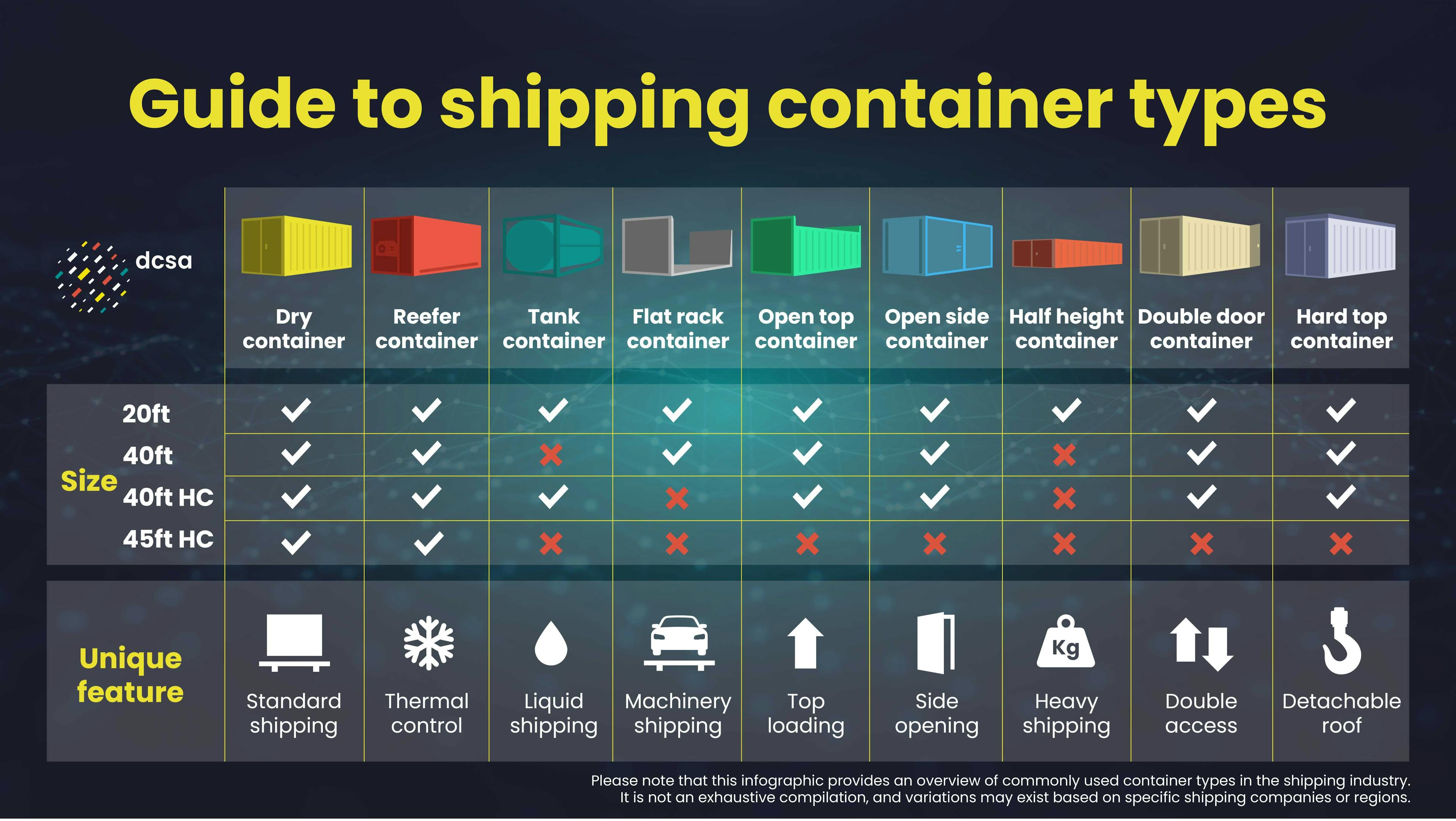Types of containers
The type and size of cargo in a shipment will determine which ocean shipping container type should be used. A container will be more or less suitable depending on a cargo’s weight and density, its form – solid, liquid, gas etc. – whether it is temperature-sensitive, and so forth.Below, we’ve put together an overview of nine common container types, together with their International Organization for Standardization (ISO) type codes. An ISO size and type code is a four-character code of letters and numbers, displayed on each container, which identifies the container’s length, height, and type code designation. The first two characters are codes that represent length and height respectively in feet and inches. Characters three and four provide the type and other characteristics. Lengths, heights and characteristics are represented with the letter ‘X’ in the descriptors below; for full codes visit bic-code.org/size-type-code.1. Dry container
This is the most common type of container. It is used to transport cargo contained within pallets, boxes, flexitanks, barrels and suchlike, when a controlled temperature isn’t needed. Dry containers come in 20ft, 40ft, 48ft, 53ft and 40ft high cube (HC). A HC container is 1ft taller than a standard container. The ISO type code for a dry container is XXGX where “G” stands for “general purpose”.2. Reefer container
Reefer containers are refrigerated. They transport goods that must be stored at a particular temperature, such as foodstuffs and medicines. They have a temperature range of -65°C to +40°C and come in 20ft, 40ft, 40ft HC and 45ft HC. Reefer containers can be expensive because of the cost of energy to maintain temperature. The ISO type code for them is XXRX where “R” stands for “Reefer”.3. Tank container
Tank containers are cylindrical and made of anti-corrosive material to transport gasses, and liquids, including dangerous cargo. They are 20ft and 40ft in size and have an ISO type code of XXTX where “T” stands for “Tank”.4. Flat rack container
Flat rack containers typically come in 20ft and 40ft and are open on their long sides to take large cargo such as machinery, vehicles and pipes. The ISO type code for flat rack containers is XXPX where “P” stands for “Platform”.5. Open top container
Open top containers have a tarpaulin instead of a solid roof. They are ideal for cargo that can’t be loaded through the door, such as machinery, as they can be loaded from above. They have a larger capacity than standard containers, come in 20ft, 40ft and 40ft HC and have an ISO type code of XXUX.6. Open side container
An open side container is also known as a side door container, so it is not surprising to learn it has doors that open on the long side to load cargo that can’t fit through the narrower end doors. These containers come in 20ft, 40ft and 40ft HC. The ISO type code for an open side container is also XXUX.7. Half height container
Half height containers transport heavy goods that don’t require the height of a standard container. They tend to be used for bulk goods and are 20ft in size. The ISO codes are typically X8UX, with the character 8 indicating “half-height”.8. Double door container
Double door containers have doors at both ends to load and unload from either. This can be convenient for transporting cargo such as cars. Double door containers come in the same dimensions as the dry containers and have the same XXGX ISO code.9. Hard top container
Hard top containers, in 20ft, 40ft or 40ft HC, have a detachable steel roof. They transport heavy goods, such as raw materials, and tall cargo, such as large machinery, which is loaded from above. They are a variant of the open top container, hence, carry the XXUX ISO code.Sources: Container xChange; Bureau International des Containers (BIC) et du Transport Intermodal; Maersk.The broad range of shipping containers available suit diverse needs to transport goods of all types, sizes and weights. Various factors, such as the nature of the cargo, its size, weight, form, fragility, and other special requirements will determine the best type of shipping container for a specific cargo. The expertise of freight forwarders, shipping companies, and logistics professionals is crucial in making informed decisions about container selection.About DCSA
DCSA’s role is to lead the container shipping industry towards collaboration by creating open-source digital standards based on shared industry requirements.These digital shipping standards enable interoperability, for seamless data exchange regardless of technology platform, so supply chain partners can establish rapid communication pathways and act on information faster. The standards are API-based for real-time communication and the capability to dynamically query systems and subscribe to automatic status updates.DCSA’s standards establish common definitions and frameworks for digitalising data and common protocols for communicating it. They include:- container track and trace for cross-carrier shipment tracking
- reefer events for reefer track and trace.
